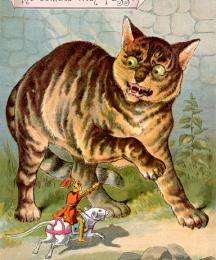The bestiary tradition attributes two major features to cats; first, they attack mice, and second, they have excellent vision (161). These two traits do shape the depictions of cats in medieval art and literature. For example, Joyce Salisbury describes an image in the book of Kells which shows two cats having caught mice nibbling on a host, of which she said, “the cats in this case represent the quintessential guardians fulfilling their one expected role of keeping the mouse population under control” (65). Cats are rare in medieval Arthuriana, and their appearances do not seem to draw on their bestiary description. One particular cat proves a dangerous foe in a battle with King
Arthur. In the Middle English
Prose Merlin, the last battle Arthur fights is against a giant, coal black demon cat.
Merlin provides the cat's backstory; when a local man goes fishing, he promises to give the first fish he catches to God. The fish is large and wonderful, so the man decides to keep it and dedicate the second fish he catches to God, instead. When the man fails to dedicate the first or the second fish he catches to God, God becomes angry and causes the man to catch a small black kitten, which the man takes home to deal with rats and mice. The kitten grows into a great cat and kills the man and his family (313). When Arthur encounters the cat, it is fully grown and terrorizing the countryside. The text is remarkably detailed about the bites and scratches Arthur endures – as well as about the knights' shame at leaving Arthur to fight the cat alone once they see the size of its claws (313-16). This battle is also recounted in the Vulgate Cycle's
Merlin,...
Read More
The bestiary tradition attributes two major features to cats; first, they attack mice, and second, they have excellent vision (161). These two traits do shape the depictions of cats in medieval art and literature. For example, Joyce Salisbury describes an image in the book of Kells which shows two cats having caught mice nibbling on a host, of which she said, “the cats in this case represent the quintessential guardians fulfilling their one expected role of keeping the mouse population under control” (65). Cats are rare in medieval Arthuriana, and their appearances do not seem to draw on their bestiary description. One particular cat proves a dangerous foe in a battle with King
Arthur. In the Middle English
Prose Merlin, the last battle Arthur fights is against a giant, coal black demon cat.
Merlin provides the cat's backstory; when a local man goes fishing, he promises to give the first fish he catches to God. The fish is large and wonderful, so the man decides to keep it and dedicate the second fish he catches to God, instead. When the man fails to dedicate the first or the second fish he catches to God, God becomes angry and causes the man to catch a small black kitten, which the man takes home to deal with rats and mice. The kitten grows into a great cat and kills the man and his family (313). When Arthur encounters the cat, it is fully grown and terrorizing the countryside. The text is remarkably detailed about the bites and scratches Arthur endures – as well as about the knights' shame at leaving Arthur to fight the cat alone once they see the size of its claws (313-16). This battle is also recounted in the Vulgate Cycle's
Merlin, the source for the Middle English version, and the cat here has the same backstory as the giant cat in the Middle English version of the tale (1.410-411). In a similar account in the
Romanz des Franceis, the menacing cat is victorious; it kills Arthur in battle and becomes king (
Arthurian Name Dictionary, 111).
A Welsh version of this cat exists, as well – Cath Baluc, or Palug's Cat, is a monstrous creature defeated by Cei in some stories, such as the poem
Pa Gwr. Palug’s Cat is mentioned in “Tri Gwrdueichyat Enys Prydein,” Thee Powerful Swineherds of the Island of Britain, one of the Welsh triads. Rachel Bromwich has suggested that the creature is likely related to sea cats in Irish folklore (474).
The images included here feature cats in the Tom Thumb tradition, in particular a scene where the miniature knight is threatened by a cat.
BibliographyBromwich, Rachel, ed. Trioedd ynys Prydein: The Triads of the Island of Britain. 3rd ed. Cardiff: University of Wales Press, 2006.
Bruce, Christopher W. The Arthurian Name Dictionary. New York: Garland, 1999.
Salisbury, Joyce E. The Beast Within: Animals in the Middle Ages. New York: Routledge, 1994.
For more information about the version of works cited, see the Critical Bibliography for this project.
Read Less









